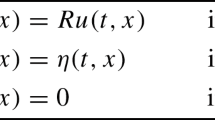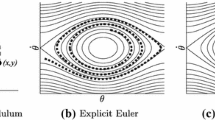Abstract
Numerical methods that preserve geometric invariants of the system, such as energy, momentum or the symplectic form, are called geometric integrators. In this paper we present a method to construct symplectic-momentum integrators for higher-order Lagrangian systems. Given a regular higher-order Lagrangian \(L:T^{(k)}Q\rightarrow {\mathbb {R}}\) with \(k\ge 1\), the resulting discrete equations define a generally implicit numerical integrator algorithm on \(T^{(k-1)}Q\times T^{(k-1)}Q\) that approximates the flow of the higher-order Euler–Lagrange equations for L. The algorithm equations are called higher-order discrete Euler–Lagrange equations and constitute a variational integrator for higher-order mechanical systems. The general idea for those variational integrators is to directly discretize Hamilton’s principle rather than the equations of motion in a way that preserves the invariants of the original system, notably the symplectic form and, via a discrete version of Noether’s theorem, the momentum map. We construct an exact discrete Lagrangian \(L_d^e\) using the locally unique solution of the higher-order Euler–Lagrange equations for L with boundary conditions. By taking the discrete Lagrangian as an approximation of \(L_d^e\), we obtain variational integrators for higher-order mechanical systems. We apply our techniques to optimal control problems since, given a cost function, the optimal control problem is understood as a second-order variational problem.







Similar content being viewed by others
Notes
For \(k=1\), recall writing \(\delta \dot{q}=\dot{(\delta q)}\) when deriving the Euler–Lagrange equations, assuming that q is \(C^2\).
By this we mean, from now on, that there exists \(h_0>0\) such that for all \(h\in (0,h_0)\) the definition or proof holds.
References
Abraham, R., Marsden, J.E., Ratiu, T.: Manifolds, Tensor Analysis, and Applications, vol. 75 of Applied Mathematical Sciences, 2nd edn. Springer, New York (1988). doi:10.1007/978-1-4612-1029-0
Agarwal, R.P.: Boundary Value Problems for Higher Order Differential Equations. World Scientific Publishing Co., Inc., Teaneck (1986). doi:10.1142/0266
Benito, R., de León, M., Martín de Diego, D.: Higher-order discrete Lagrangian mechanics. Int. J. Geom. Methods Mod. Phys. 3, 421–436 (2006). doi:10.1142/S0219887806001235
Bloch, A.M.: Nonholonomic Mechanics and Control, vol. 24 of Interdisciplinary Applied Mathematics. Springer, New York (2003). doi:10.1007/b97376. With the collaboration of J. Baillieul, P. Crouch and J. Marsden, With scientific input from P. S. Krishnaprasad, R. M. Murray and D. Zenkov, Systems and Control
Bloch, A.M., Hussein, I.I., Leok, M., Sanyal, A.K.: Geometric structure-preserving optimal control of a rigid body. J. Dyn. Control Syst. 15, 307–330 (2009). doi:10.1007/s10883-009-9071-2
Bullo, F., Lewis, A.D.: Geometric Control of Mechanical Systems, vol. 49 of Texts in Applied Mathematics. Springer, New York (2005). doi:10.1007/978-1-4899-7276-7. Modeling, analysis, and design for simple mechanical control systems
Burnett, C.L., Holm, D.D., Meier, D.M.: Inexact trajectory planning and inverse problems in the Hamilton-Pontryagin framework. Proc. R. Soc. Lond. Ser. A Math. Phys. Eng. Sci. 469, 20130249 (2013). doi:10.1098/rspa.2013.0249
Buttazzo, G., Giaquinta, M., Hildebrandt, S.: One-Dimensional Variational Problems, an Introduction, vol. 15 of Oxford Lecture Series in Mathematics and its Applications. The Clarendon Press, Oxford University Press, New York (1998)
Colombo, L., Martín de Diego, D., Zuccalli, M.: On variational integrators for optimal control of mechanical control systems. Rev. R. Acad. Cienc. Exactas Fís. Nat. Ser. A Math. RACSAM 106, 161–171 (2012). doi:10.1007/s13398-011-0032-8
Colombo, L., Martín de Diego, D., Zuccalli, M.: Higher-order discrete variational problems with constraints. J. Math. Phys. 54, 093507 (2013). doi:10.1063/1.4820817
Colombo, L., Martín de Diego, D.: Higher-order variational problems on Lie groups and optimal control applications. J. Geom. Mech. 6, 451–478 (2014). doi:10.3934/jgm.2014.6.451
Crampin, M., Sarlet, W., Cantrijn, F.: Higher-order differential equations and higher-order Lagrangian mechanics. Math. Proc. Cambridge Philos. Soc. 99, 565–587 (1986). doi:10.1017/S0305004100064501
Crouch, P., Silva Leite, F.: The dynamic interpolation problem: on Riemannian manifolds, Lie groups, and symmetric spaces. J. Dynam. Control Syst. 1, 177–202 (1995). doi:10.1007/BF02254638
de León, M., Rodrigues, P.R.: Generalized Classical Mechanics and Field Theory, vol. 112 of North-Holland Mathematics Studies. North-Holland Publishing Co., Amsterdam (1985). A geometrical approach of Lagrangian and Hamiltonian formalisms involving higher order derivatives, Notes on Pure Mathematics, 102
Eldering, J.: Persistence of noncompact normally hyperbolic invariant manifolds in bounded geometry, PhD thesis, Universiteit Utrecht (2012)
Gay-Balmaz, F., Holm, D.D., Ratiu, T.S.: Higher order Lagrange-Poincaré and Hamilton-Poincaré reductions. Bull. Braz. Math. Soc. (N.S.) 42, 579–606 (2011). doi:10.1007/s00574-011-0030-7
Gay-Balmaz, F., Holm, D.D., Meier, D.M., Ratiu, T.S., Vialard, F.-X.: Invariant higher-order variational problems. Comm. Math. Phys. 309, 413–458 (2012). doi:10.1007/s00220-011-1313-y
Gay-Balmaz, F., Holm, D.D., Meier, D.M., Ratiu, T.S., Vialard, F.-X.: Invariant higher-order variational problems II. J. Nonlinear Sci. 22, 553–597 (2012). doi:10.1007/s00332-012-9137-2
Giaquinta, M., Hildebrandt, S.: Calculus of Variations I, vol. 310 of Grundlehren der Mathematischen Wissenschaften [Fundamental Principles of Mathematical Sciences]. Springer, Berlin (1996)
Hussein, I.I., Bloch, A.M.: Dynamic interpolation on Riemannian manifolds: an application to interferometric imaging, In: Proceedings of the 2004 American control conference, pp. 685–690 (2004)
Jordan, B.W., Polak, E.: Theory of a class of discrete optimal control systems. J. Electron. Control (1) 17, 697–711 (1964)
Lee, T., Leok, M., McClamroch, N.H.: Optimal attitude control of a rigid body using geometrically exact computations on \({\rm SO}(3)\). J. Dyn. Control Syst. 14, 465–487 (2008). doi:10.1007/s10883-008-9047-7
Leok, M., Shingel, T.: Prolongation-collocation variational integrators. IMA J. Numer. Anal. 32, 1194–1216 (2012). doi:10.1093/imanum/drr042
Machado, L., Silva Leite, F., Krakowski, K.: Higher-order smoothing splines versus least squares problems on Riemannian manifolds. J. Dyn. Control Syst. 16, 121–148 (2010). doi:10.1007/s10883-010-9080-1
Marsden, J.E., West, M.: Discrete mechanics and variational integrators. Acta Numer. 10, 357–514 (2001). doi:10.1017/S096249290100006X
Murray, R.N., Li, Z.X., Sastry, S.S.: A mathematical introduction to robotic manipulation. CRC Press, Boca Raton (1994)
Noakes, L., Heinzinger, G., Paden, B.: Cubic splines on curved spaces. IMA J. Math. Control Inform. 6, 465–473 (1989). doi:10.1093/imamci/6.4.465
Ober-Blöbaum, S., Junge, O., Marsden, J.E.: Discrete mechanics and optimal control: an analysis. ESAIM Control Optim. Calc. Var. 17, 322–352 (2011). doi:10.1051/cocv/2010012
Patrick, G.W.: Lagrangian mechanics without ordinary differential equations. Rep. Math. Phys. 57, 437–443 (2006). doi:10.1016/S0034-4877(06)80030-3
Patrick, G.W., Cuell, C.: Error analysis of variational integrators of unconstrained Lagrangian systems. Numer. Math. 113, 243–264 (2009). doi:10.1007/s00211-009-0245-3
Veselov, A.P.: Integrable systems with discrete time, and difference operators. Funktsional. Anal. i Prilozhen. 22, 1–13 (1988). doi:10.1007/BF01077598
Wendlandt, J.M., Marsden, J.E.: Mechanical integrators derived from a discrete variational principle. Phys. D 106, 223–246 (1997). doi:10.1016/S0167-2789(97)00051-1
Acknowledgments
This work has been supported by MICINN (Spain) Grant MTM 2013-42870-P, ICMAT Severo Ochoa Project SEV-2011-0087 and IRSES-project “Geomech-246981.” The research of S. Ferraro has been supported by CONICET Argentina (PIP 2013-2015 GI 11220120100532CO), ANPCyT Argentina (PICT 2013-1302) and SGCyT UNS. We would like to thank the referee for the helpful comments.
Author information
Authors and Affiliations
Corresponding author
Additional information
Communicated by Anthony Bloch.
Appendix: A Technical Result for Sect. 2
Appendix: A Technical Result for Sect. 2
Let E be the kernel of g, where \(g=(g_0,\ldots ,g_{k-1}):C^{l}([0,1],{\mathbb {R}}^{n})\rightarrow ({\mathbb {R}}^{n})^{k}\) and \(g_{j}[\cdot ]=\langle \langle b_{j}^{[k]},\cdot \rangle \rangle \). In the context of Sect. 2.5, E is the tangent space of the constraint set defined using the linear constraints \(g_{j}\), and l is either 0 or k.
In this Appendix we show that the orthogonal complement of E is the space F of \({\mathbb {R}}^{n}\)-valued polynomials of degree at most \(k-1\),
where \(b_j^{[k]}\), \(j=0,\ldots ,k-1\), is a basis of the space of real-valued polynomials of degree at most \(k-1\) consisting of orthonormal polynomials on [0, 1].
Lemma 6.1
\(F=E^{\perp }\), where the orthogonal complement is taken with respect to the inner product \(\llbracket ,\rrbracket \) in \(C^{l}([0,1],{\mathbb {R}}^{n})\).
Proof
We will prove that E and F are orthogonal (with zero intersection) and that their sum is the whole space \(C^{l}([0,1],{\mathbb {R}}^{n})\).
Let \(e\in E\) and \(c^{j}b_{j}^{[k]}\in F\).
since \(e\in E={\text {Ker}}g\).
The fact that \(E\cap F=\{0\}\) can be obtained either by using that the inner product is nondegenerate or directly as follows. Take \(e\in E\cap F\), so \(e=c^{j}b_{j}^{[k]}\). For all \(j'\), we have \(0=g_{j'}[e]=\langle \langle b_{j'}^{[k]},c^{j}b_{j}^{[k]}\rangle \rangle =c^{j'}\), which means that \(e=0\).
Finally, take \(e\in C^{l}([0,1],{\mathbb {R}}^{n})\). Write
The third term is in F. The remaining part of the right-hand side is in E since for all \(j'\),

Therefore, \(C^{l}([0,1],{\mathbb {R}}^{n})=E+F\). From the first part of the proof, we obtain that there is an orthogonal decomposition \(C^{l}([0,1],{\mathbb {R}}^{n})=E\oplus F\). \(\square \)
Rights and permissions
About this article
Cite this article
Colombo, L., Ferraro, S. & Martín de Diego, D. Geometric Integrators for Higher-Order Variational Systems and Their Application to Optimal Control. J Nonlinear Sci 26, 1615–1650 (2016). https://doi.org/10.1007/s00332-016-9314-9
Received:
Accepted:
Published:
Issue Date:
DOI: https://doi.org/10.1007/s00332-016-9314-9




